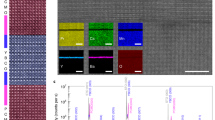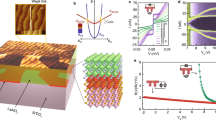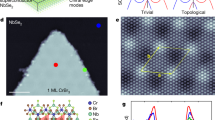Abstract
Correlated oxides display a variety of extraordinary physical properties including high-temperature superconductivity1 and colossal magnetoresistance2. In these materials, strong electronic correlations often lead to competing ground states that are sensitive to many parameters—in particular the doping level—so that complex phase diagrams are observed. A flexible way to explore the role of doping is to tune the electron or hole concentration with electric fields, as is done in standard semiconductor field effect transistors3. Here we demonstrate a model oxide system based on high-quality heterostructures in which the ferroelectric field effect approach can be studied. We use a single-crystal film of the perovskite superconductor Nb-doped SrTiO3 as the superconducting channel and ferroelectric Pb(Zr,Ti)O3 as the gate oxide. Atomic force microscopy is used to locally reverse the ferroelectric polarization, thus inducing large resistivity and carrier modulations, resulting in a clear shift in the superconducting critical temperature. Field-induced switching from the normal state to the (zero resistance) superconducting state was achieved at a well-defined temperature. This unique system could lead to a field of research in which devices are realized by locally defining in the same material superconducting and normal regions with ‘perfect’ interfaces, the interface being purely electronic. Using this approach, one could potentially design one-dimensional superconducting wires, superconducting rings and junctions, superconducting quantum interference devices (SQUIDs) or arrays of pinning centres.
This is a preview of subscription content, access via your institution
Access options
Subscribe to this journal
Receive 51 print issues and online access
$199.00 per year
only $3.90 per issue
Buy this article
- Purchase on Springer Link
- Instant access to full article PDF
Prices may be subject to local taxes which are calculated during checkout




Similar content being viewed by others
References
Bednorz, J. G. & Müller, K. A. Possible high-Tc superconductivity in the Ba-La-Cu-O system. Z. Phys. B 64, 189–193 (1986)
Tokura, Y. (ed.) Advances in Condensed Matter Science Vol. 2, Colossal Magnetoresistive Oxides (Gordon and Breach, London, 2000)
Ahn, C. H., Triscone, J.-M. & Mannhart, J. Electric field effect in correlated oxide systems. Nature 424, 1015–1018 (2003)
Schooley, J. F., Hosler, W. R. & Cohen, M. L. Superconductivity in semiconducting SrTiO3 . Phys. Rev. Lett. 12, 474–475 (1964)
Pfeiffer, E. R. & Schooley, J. F. Superconducting transition temperatures of Nb-doped SrTiO3 . Phys. Lett. A 29, 589–590 (1969)
Koonce, C. S., Cohen, M. L., Schooley, J. F., Hosler, W. R. & Pfeiffer, E. R. Superconducting transition temperatures of semiconducting SrTiO3 . Phys. Rev. 163, 380–390 (1967)
Ahn, C. H. et al. Local, nonvolatile electronic writing of epitaxial Pb(Zr0.52Ti0.48)O3/SrRuO3 heterostructures. Science 276, 1100–1103 (1997)
Takahashi, K. S. et al. Electrostatic modulation of the electronic properties of Nb-doped SrTiO3 superconducting films. Appl. Phys. Lett. 84, 1722–1724 (2004)
Müller, K. A. & Burkard, H. SrTiO3: An intrinsic quantum para-electric below 4 K. Phys. Rev. B 19, 3593–3602 (1979)
Tufte, O. N. & Chapman, P. W. Electron mobility in semiconducting strontium titanate. Phys. Rev. 155, 796–802 (1967)
Aidam, R., Fuchs, D. & Schneider, R. Ferroelectric field effect in YBa2Cu3O7-δ thin films. Physica C 328, 21–30 (1999)
Lee, C., Destry, J. & Brebner, J. L. Optical absorption and transport in semiconducting SrTiO3 . Phys. Rev. B 11, 2299–2309 (1975)
Leitner, A. et al. Pulsed laser deposition of superconducting Nb-doped strontium titanate thin films. Appl. Phys. Lett. 72, 3065–3067 (1998)
Ahn, C. H. et al. Electrostatic modulation of superconductivity in ultrathin GdBa2Cu3O7-x films. Science 284, 1152–1155 (1999)
Cassinese, A., Luca, G. M. D., Prigiobbo, A., Salluzzo, M. & Vaglio, R. Field-effect tuning of carrier density in Nd1.2Ba1.8Cu3Oy thin films. Appl. Phys. Lett. 84, 3933–3935 (2004)
Parendo, K. A. et al. Electrostatic tuning of the superconductor-insulator transition in two dimensions. Phys. Rev. Lett. 94, 197004 (2005)
Werthamer, N. R., Helfand, E. & Hohenberg, P. C. Temperature and purity dependence of superconducting critical field Hc2. III. Electron spin and spin-orbit effects. Phys. Rev. 147, 295–302 (1966)
Takahashi, K. S. et al. Epitaxial growth and transport properties of Nb-doped SrTiO3 thin films. Proc. SPIE 5932, 267–274 (2005)
Tinkham, M. Introduction to Superconductivity 2nd edn (McGraw-Hill, New York, 1996)
Kosterlitz, J. M. & Thouless, D. J. Long range order and metastability in two dimensional solids and superfluids. J. Phys. C 5, L124–L126 (1972)
Minnhagen, P. The two-dimensional Coulomb gas, vortex unbinding, and superfluid-superconducting films. Rev. Mod. Phys. 59, 1001–1066 (1987)
Beasley, M. R., Mooji, J. E. & Orlando, T. P. Possibility of vortex-antivortex pair dissociation in two-dimensional superconductors. Phys. Rev. Lett. 42, 1165–1168 (1979)
Gabay, M. & Kapitulnik, A. Vortex-antivortex crystallization in thin superconducting and superfluid films. Phys. Rev. Lett. 71, 2138–2141 (1993)
Ohashi, S. et al. Compact laser molecular beam epitaxy system using laser heating of substrate for oxide film growth. Rev. Sci. Instrum. 70, 178–183 (1999)
Acknowledgements
We thank M. Dawber for a careful reading of the manuscript. This work was supported by the Swiss National Science Foundation through the National Center of Competence in Research, ‘Materials with Novel Electronic Properties, MaNEP’ and division II, New Energy and Industrial Technology Development Organization (NEDO) of Japan, and ESF (Thiox).
Author information
Authors and Affiliations
Corresponding author
Ethics declarations
Competing interests
Reprints and permissions information is available at npg.nature.com/reprintsandpermissions. The authors declare no competing financial interests.
Rights and permissions
About this article
Cite this article
Takahashi, K., Gabay, M., Jaccard, D. et al. Local switching of two-dimensional superconductivity using the ferroelectric field effect. Nature 441, 195–198 (2006). https://doi.org/10.1038/nature04731
Received:
Accepted:
Issue Date:
DOI: https://doi.org/10.1038/nature04731
This article is cited by
-
Electrical switching of a bistable moiré superconductor
Nature Nanotechnology (2023)
-
Two-dimensional superconductors with intrinsic p-wave pairing or nontrivial band topology
Science China Physics, Mechanics & Astronomy (2023)
-
Emergent properties at oxide interfaces controlled by ferroelectric polarization
npj Computational Materials (2021)
-
Vortex States in a Multigeometric Mesoscopic Superconductor
Journal of Low Temperature Physics (2020)
-
Induced Anisotropy by the Inclusion of Defects of Variable \(T_\mathrm{c}\) T c in a Superconducting Disk
Journal of Low Temperature Physics (2018)
Comments
By submitting a comment you agree to abide by our Terms and Community Guidelines. If you find something abusive or that does not comply with our terms or guidelines please flag it as inappropriate.



